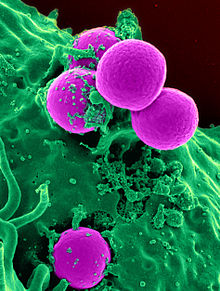Methicillin-resistant Staphylococcus aureus (MRSA)
| Methicillin-resistant Staphylococcus aureus | |
|---|---|
 |
|
| Scanning electron micrograph of a human neutrophil ingesting MRSA | |
| Scientific classification | |
| Domain: | Bacteria |
| Kingdom: | Eubacteria |
| Phylum: | Firmicutes |
| Class: | Bacilli |
| Order: | Bacillales |
| Family: | Staphylococcaceae |
| Genus: | Staphylococcus |
| Species: | S. aureus |
| Binomial name | |
|
Staphylococcus aureus |
|
Methicillin-resistant Staphylococcus aureus (MRSA) (/ɛmɑːrɛseɪ/ or /ˈmɜːrsə/) is a gram-positive bacterium that is genetically different from other strains of Staphylococcus aureus. MRSA is responsible for several difficult-to-treat infections in humans. MRSA is any strain of S. aureus that has developed, through horizontal gene transfer and natural selection, multiple drug resistance to beta-lactam antibiotics. β-lactam antibiotics are a broad spectrum group which includes some penams – penicillin derivatives such as methicillin and oxacillin, and cephems such as the cephalosporins. Strains unable to resist these antibiotics are classified as methicillin-susceptible Staphylococcus aureus, or MSSA.
MRSA is prevalent in hospitals, prisons, and nursing homes, where people with open wounds, invasive devices such as catheters, and weakened immune systems are at greater risk of nosocomial infection (hospital-acquired infection). MRSA began as a hospital-acquired infection, but has developed limited endemic status and is now community-acquired as well as livestock-acquired. The terms HA-MRSA (healthcare-associated or hospital-acquired MRSA), CA-MRSA (community-associated MRSA) and LA-MRSA (livestock-associated) reflect this distinction.
...
Wikipedia
